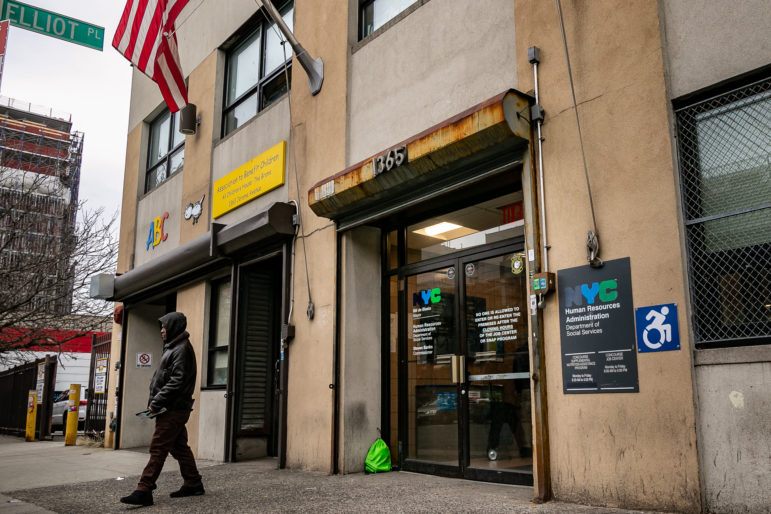The first four months of Fiscal Year 2024 saw timely processing of just 14.3 percent of cash assistance applications—a new low—and 41.6 percent of SNAP applications. Delays can have serious consequences for applicants, from hunger to missed rent payments that can put families at risk of eviction.

Adi Talwar
An HRA walk-in center at 1365 Jerome Avenue in the Bronx, which is slated to close in February.New York City’s last fiscal year saw timely processing of cash and food assistance applications spiral to new lows, and data released Tuesday show that Mayor Eric Adams’ administration had failed to right the ship as of October.
The first four months of Fiscal Year 2024, or July through October of 2023, saw timely processing of just 14.3 percent of cash assistance applications, according to the new Preliminary Mayor’s Management Report (PMMR).
That’s down from 28.8 percent in Fiscal Year 2023 and 55 percent in July through October 2022—and well below the city’s stated target of 96 percent. The Adams administration has attributed its struggles, in part, to a surge in applications.
Cash assistance includes both small, semimonthly payments for the lowest-income New Yorkers, historically known as welfare, and larger, one-time grants for emergency needs like rent, also known as one-shot deals.
Applications for Supplemental Nutrition Assistance Program (SNAP), commonly referred to as food stamps, saw a slightly improved processing rate at the top of the current fiscal year—41.6 percent, compared to 39.7 percent last fiscal year and 40.8 percent in July through October 2022.
The city’s SNAP target is 90.6 percent timeliness. City Limits first reported on mounting SNAP processing delays in the fall of 2022.
Under federal and state law, all SNAP and cash assistance applications and recertifications must be processed by the Human Resources Administration (HRA), part of the Department of Social Services (DSS), within 30 days. Anything pending beyond that threshold is considered delayed.
Delayed processing can have serious consequences for applicants—from hunger to missed rent payments that can put families at risk of eviction.
The new timeliness numbers are scary, said Diana Ramos, a benefits recipient and leader with the Safety Net Project at the Urban Justice Center. Particularly the cash assistance data.
“I can’t believe that those numbers are even worse,” she said. “That is absolutely ridiculous because there’s many people that rely on these things.”
Ramos added that the news comes ahead of a planned closure of an HRA walk-in center at 1365 Jerome Ave. in the Bronx on Feb. 16. Some services will move to a Hunts Point location at 845 Barretto St. on Feb. 20, according to an email circulated by DSS. An agency spokesperson characterized the move as a relocation, rather than a closure.
“And then he’s… closing another office,” Ramos said of the mayor. “It makes me think, do you even care about your citizens?”
Despite delays, the number of people receiving benefits has increased year-over-year. There were 495,600 people receiving cash assistance in October 2023, according to HRA, up 13 percent from October 2022. There were about 1.7 million people receiving SNAP as of October, compared to 1.68 million the year prior.*
Reached for comment, HRA emphasized the increase in cash assistance applications. The agency saw 191,400 applications between July and October, according to the PMMR, up 22 percent from the year prior and 73 percent from that same period in 2018. The report does not track SNAP applications.
"While we have made significant progress addressing backlogs, during the first four months of FY24 we saw a more than 70 percent increase in cash assistance applications when compared to pre-pandemic years which clearly impacted the timeliness rates for this time period," HRA said in a statement.
"To address this increased need, DSS has significantly increased staffing levels for processing these applications and we continue to hire and train staff, implement process improvements, and streamline our highly effective remote processes to help get New Yorkers the benefits they need in a more efficient way," the statement continued.
Even as staff increase, the mayor's latest budget proposal calls for fewer full-time positions in relevant HRA "program areas" than his first proposal in 2022: from 1,302 to 1,231 in "Food Stamp Operations," and from 3,172 to 2,657 in "Public Assistance and Employment Administration."
Earlier this week, City Limits reported on a related issue: Not only is timely processing down, but applicants for cash assistance are facing a surge in application denials, mostly for procedural issues. For example, the most common denial issued between July and September 2023 was for failure to complete a mandatory phone interview.
The city launched a phone system for interviews in response to the pandemic, but applicants and advocates say they struggle to get through.
HRA is under court order to eliminate its backlogs for both SNAP and cash assistance by March 2024.
To reach the reporter behind this story, contact Emma@citylimits.org. To reach the editor, contact Jeanmarie@citylimits.org.
*This story has been updated since original publication to correct a typo in the number of SNAP recipients; it is in the millions, not billions. City Limits regrets the error.








